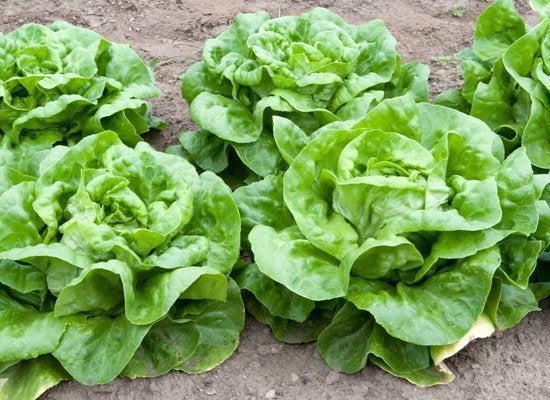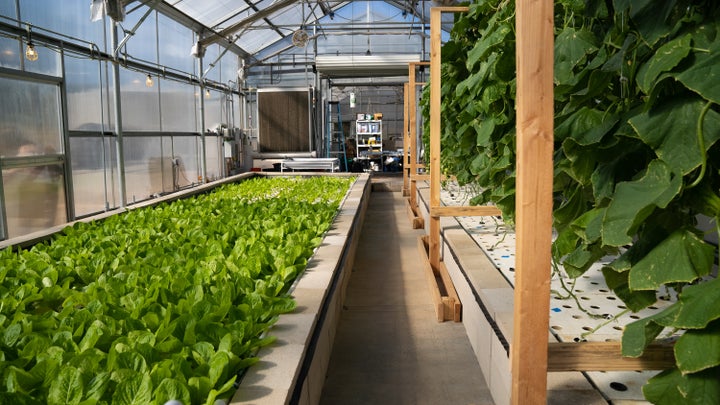
Today, surrounded by freezing temperatures, thousands of heads of lettuce grow, nestled in a cozy greenhouse fed by nutrient-rich nitrates. Or you could call it what it is: fish poop.
The process, called aquaponics, allows farmers to grow local, organic produce anywhere at any time of year.
Aquaponics is a sustainable method of farming that combines aquaculture (raising fish) and hydroponics (cultivating plants in water). In a recirculating system, fish waste and bacteria provide nutrients to growing plants. The water from fish is thoroughly filtered and only comes in contact with the roots, minimizing the potential for contamination. Plants then take up those nutrients and return clean water to the fish.
In large facilities in Wisconsin and suburban San Diego, as well as small urban lots and classrooms across the nation, fish poop is being used to help solve some of the most challenging problems that farmers will face in our future: How to feed a world population expected to reach nearly 10 billion by 2050, according to UN projections; how to contend with declining reserves of groundwater; and how to viably provide fresh food to an increasing urban population.
Agricultural innovators are successfully turning to aquaponics to grow food that saves water and uses less land while providing produce and protein.
Fish poop: It’s more efficient than you’d think.
When vegetables ― especially leafy greens ― have access to filtered, recirculating water via aquaponics, they thrive, require less water and land and grow without pesticides.
At Ecolife’s Aquaponics Innovation Center in northern San Diego County, over 200 pounds of food is grown and distributed to food banks each month. The non-governmental organization’s mission is to provide education to the community about farming that reduces clearcutting (the practice of uniformly cutting down trees) and uses land and water efficiently. According to Martin Niwinski, resident scientist and lead aquaponics technician at Ecolife, since nutrients are constantly available to plants’ roots, plants can grow up to 25 percent faster than in soil.
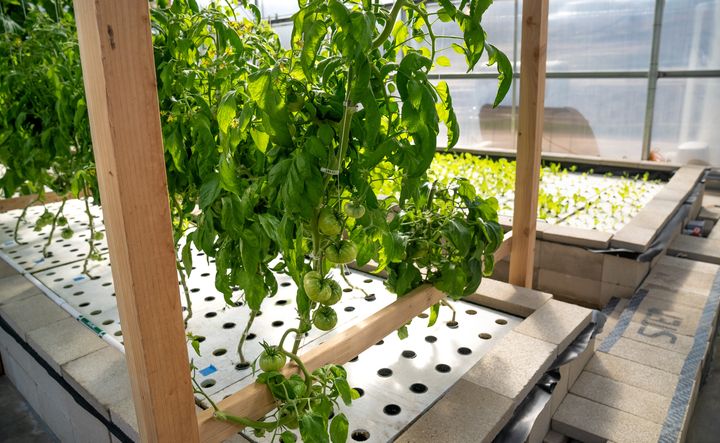
Superior Fresh, the world’s largest aquaponics facility, located in rural Hixton, Wisconsin, opened in August 2017 with a vision to change the world through sustainable agriculture and healthy food. Its 123,000-square-foot greenhouse and 1-acre fish farm provide leafy greens to retailers, restaurants, schools and hospitals all over the Midwest, according to president Brandon Gottsacker. Superior Fresh plans to expand its distribution of leafy greens and begin selling its Atlantic salmon to markets later this year.
One of the benefits of aquaponics is its ability to grow produce year-round. lead grower Adam Shinner told HuffPost that at Superior Fresh, “This type of technology allows you to produce the freshest and healthiest products year-round. ... We deal with the cold winters by using our high-tech control systems that will detect how cold it is outside and modulate our heating system to keep the growing systems at optimal temperature for the fish and plants.”
Aquaponics requires only a tiny amount of space to function.
On a once-vacant lot in Brooklyn, Oko Farms’ 2,500-square-foot aquaponics system offers a testament to aquaponics operating successfully in a small urban spaces. The farm provides workshops for schoolchildren and adults.
Yemi Amu, co-founder, farm manager and former nutrition educator, founded the farm in part to provide fresh produce for clients. Leaders in aquaponics also see potential for sites on urban rooftops and in vacant warehouses.
Aquaponics doesn’t rely on groundwater, which we’re running dangerously low on.
Seventy percent of all available freshwater is used for agriculture. Throughout the world, groundwater is being depleted at dangerous levels. Kubi Ackerman, director of the Future City Lab at the Museum of the City of New York, and former project manager at Urban Design Lab, where he researched urban agriculture, told HuffPost, “In the Midwest and California, as well as in many of the world’s ‘breadbasket’ regions, climate projections indicate significant water scarcity and drought.” A 2018 study by several NASA satellites confirms that groundwater is seriously taxed around the globe.
Aquaponics serves as a hopeful solution to decreasing water availability. Niwinski told HuffPost that in traditional soil farming, “The largest loss of water is through infiltration, water percolating into the ground that is not used by the plants’ roots.” This is never the case with aquaponics. Ecolife technicians measure water usage at their site via a flow meter from the water source, according to Niwinski.
Aquaponics specialist Jackson Gross, MSPH Ph.D. at UC Davis, told HuffPost that on average, raising food using aquaponics or hydroponics can save about 90 percent of water in comparison to conventional farming. He points to a 2015 study facilitated by researchers at Arizona State University comparing lettuce grown in soil to lettuce with roots exposed to nutrient-rich water. Lettuce grown hydroponically used, on average, 10 percent the amount of water as lettuce grown in soil. “Those numbers would be different depending on the crops grown but for lettuce it is a fair number,” Gross told HuffPost.
And it help as we continue to face chronic droughts, as well.
Niwinski points out aquaponics is a viable way to provide food in drought-ridden environments. “Aquaponics makes a lot of sense in places with low water security like San Diego, where 85 percent of water is imported.” Niwinski touts the promise of the growing system’s low impact on the environment. Because aquaponics relies on a closed-loop recirculating system, water is greatly conserved. He states, “No water or nutrients have ever left the system.” Because fish are vital to the loop, any pesticides that would harm them cannot be used, and are never released to the surrounding environment.
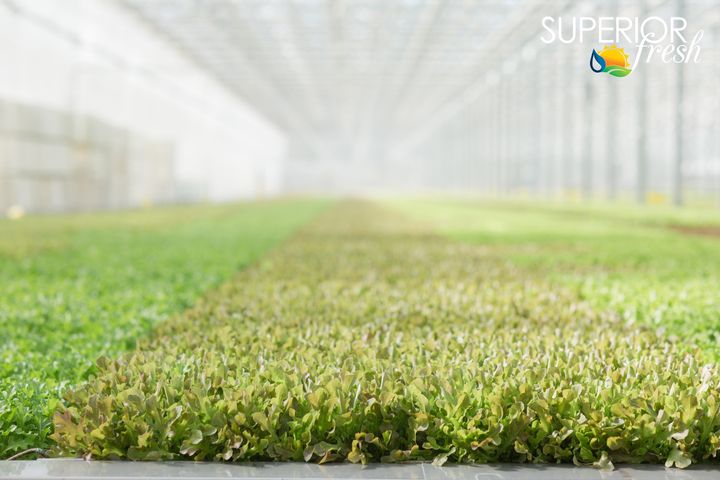
Near UC Davis, Gross has helped the university partner with a northern California caviar producer to grow sustainable lettuce at a 24,000-square-foot aquaponics site. “I see aquaponics as a major contributor to the reutilization of waste streams from large aquaculture farms into nutrient streams for vegetable plant production. We repurpose manure from cows and chickens, it should be of no surprise we would also be utilizing the wastes from aquaculture,” he said.
But aquaponics can’t solve all our food-growing problems.
Those who lead the way in the future of food don’t see aquaponics as a replacement for conventional agriculture, but an addition to the innovation needed to feed the world’s growing population.
Ackerman sees aquaponics’ potential as most useful in dense urban environments. He notes that it can reduce food transportation costs, provide job opportunities and provide more equitable access to healthy food. “From a resiliency prospective, it’s important to rely on a diversity of sources in the future of agriculture,” he told HuffPost.
“Aquaponics conserves both water and land, provides a sustainable and locally grown source source of protein (fish), and can grow a variety of vegetables that appeal to New York City’s diverse ethnic demographic,” Amu said.
Aquaponics isn’t cheap, nor is it energy-efficient yet.
Startup costs can be daunting, but also vary widely.
Superior Fresh, with its 123,000 square feet of production space and 850,000 gallons, needed a nearly $20 million investment to create the largest aquaponics facility in the world.
Ecolife’s 1,100 square-foot nonprofit center cost $15,000 in materials to build. Though urban Oko Farms is the largest aquaponics facility in New York City, its modest 2,500 square feet cost $5,000, including volunteer labor and donated materials, according to Amu.
The government’s new Food Bill earmarks money for Controlled-Environment Agriculture (CEAs) such as aquaponics and seems to demonstrate a commitment to learn and grow CEAs from an infancy stage to their full potential.
But energy efficiency is the largest hurdle that aquaponics innovators need to overcome. Arizona’s 2015 study found that aquaponics and hydroponics currently use significantly more energy than conventional agriculture in terms of heating and cooling, and supplemental lighting systems. Niwinski reports that at Ecolife, the center’s highest daily costs are from heating the fish pond to accommodate warm water for the tilapia, one of the most commonly used fish in aquaponics.
The final hurdle: Teaching farmers how to do aquaponics.
Another challenge facing agriculture is the need for well-trained, knowledgeable farmers. To successfully master aquaponics’ symbiotic system, Niwinski has been training and studying for four years. The average age of a farmer in the U.S is 56, and many older farmers don’t want to start fresh with new training.
Programs such as the ones at Oko Farms and Ecolife are bridging this gap by educating students. Amu told HuffPost that “New York City children don’t often get the opportunity to interact with farm animals, so our fish are a big attraction. Our in-school program provides students with the opportunity to become aquaponic gardeners themselves. We help students connect food production to environmental sustainability, creativity and wellness and are inspiring a new generation of farmers and environmentalists.”
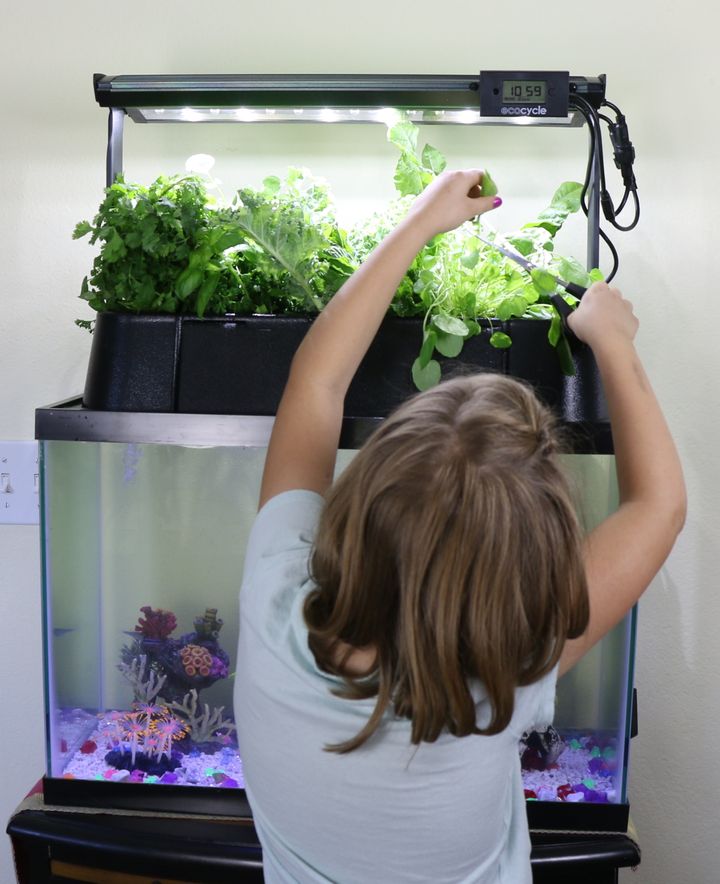
Oko Farms’ mission is to increase the number of individuals in NYC with the knowledge and skills to practice aquaponics so that it can become an accessible form of food production in the city. They also train adults including teachers, non-profit professionals, chefs, engineers, entrepreneurs, and individuals who are passionate about food security and environmental sustainability.
Ecolife’s Education Program has connected over 600 classrooms nationwide with 20-gallon aquaponics growing systems in order to introduce kids to innovative ways to grow food. Education coordinator Connor Leone enthusiastically told HuffPost that “the big picture of our classroom aquaponics program is allowing students to see their own role in these intricate ecosystems. Students get to see that produce doesn’t just come from the grocery store. We want them to gain the skills and confidence to grow their own food in a sustainable way.”
Jennipher Mouneimne’s second graders at Green Elementary in San Diego plant a variety of lettuces in their Ecolife aquaponics system. “My students are awe-struck when they learn that plants need nutrients to grow. We celebrate our harvest with salad parties,” she told HuffPost.
At Title 1 schools with large concentrations of low-income students, teachers’ and students’ participation with aquaponics has even deeper impacts. AP Environmental Science students at Morse High School in urban San Diego use the Ecolife tanks to study the nitrogen cycle and to perform water quality testing. In recent years, several students from each graduating class have gone to university to study environmental science, eager to find solutions to future environmental challenges.
“My classroom aquaponics system is hands-on science at its best. The students are invested in and curious about learning how to conserve water and land,” Mouneimne said.
